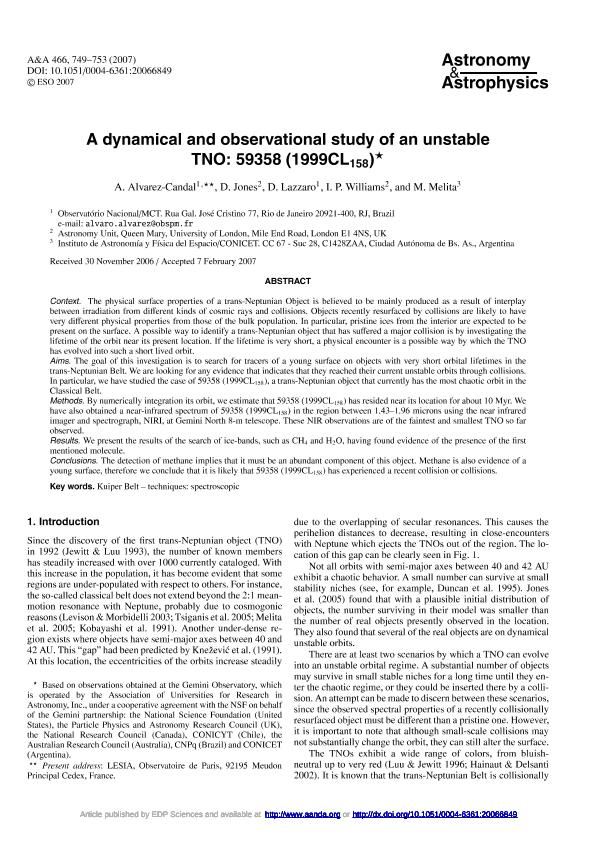Artículo
A dynamical and observational study of an unstable TNO: 59358 (1999CL158)
Fecha de publicación:
12/2007
Editorial:
EDP Sciences
Revista:
Astronomy and Astrophysics
ISSN:
0004-6361
Idioma:
Inglés
Tipo de recurso:
Artículo publicado
Clasificación temática:
Resumen
Context: The physical surface properties of a trans-Neptunian Object is believed to be mainly produced as a result of interplay between irradiation from different kinds of cosmic rays and collisions. Objects recently resurfaced by collisions are likely to have very different physical properties from those of the bulk population. In particular, pristine ices from the interior are expected to be present on the surface. A possible way to identify a trans-Neptunian object that has suffered a major collision is by investigating the lifetime of the orbit near its present location. If the lifetime is very short, a physical encounter is a possible way by which the TNO has evolved into such a short lived orbit. Aims: The goal of this investigation is to search for tracers of a young surface on objects with very short orbital lifetimes in the trans-Neptunian Belt. We are looking for any evidence that indicates that they reached their current unstable orbits through collisions. In particular, we have studied the case of 59358 (1999CL{158}), a trans-Neptunian object that currently has the most chaotic orbit in the Classical Belt. Methods: By numerically integration its orbit, we estimate that 59358 (1999CL{158}) has resided near its location for about 10 Myr. We have also obtained a near-infrared spectrum of 59358 (1999CL{158}) in the region between 1.43-1.96 microns using the near infrared imager and spectrograph, NIRI, at Gemini North 8-m telescope. These NIR observations are of the faintest and smallest TNO so far observed. Results: We present the results of the search of ice-bands, such as CH4 and H2O, having found evidence of the presence of the first mentioned molecule. Conclusions: The detection of methane implies that it must be an abundant component of this object. Methane is also evidence of a young surface, therefore we conclude that it is likely that 59358 (1999CL{158}) has experienced a recent collision or collisions.
<p>Based on observations obtained at the Gemini Observatory, which is operated by the Association of Universities for Research in Astronomy, Inc., under a cooperative agreement with the NSF on behalf of the Gemini partnership: the National Science Foundation (United States), the Particle Physics and Astronomy Research Council (UK), the National Research Council (Canada), CONICYT (Chile), the Australian Research Council (Australia), CNPq (Brazil) and CONICET (Argentina).
Palabras clave:
Kuiper Belt
,
Comets
,
Asteroids
,
Solar System Origin
Archivos asociados
Licencia
Identificadores
Colecciones
Articulos(IAFE)
Articulos de INST.DE ASTRONOMIA Y FISICA DEL ESPACIO(I)
Articulos de INST.DE ASTRONOMIA Y FISICA DEL ESPACIO(I)
Citación
Alvarez Candal, A.; Jones, D.; Lazzaro, D.; Williams, I. P.; Melita, Mario Daniel; A dynamical and observational study of an unstable TNO: 59358 (1999CL158); EDP Sciences; Astronomy and Astrophysics; 466; 2; 12-2007; 749-753
Compartir
Altmétricas




